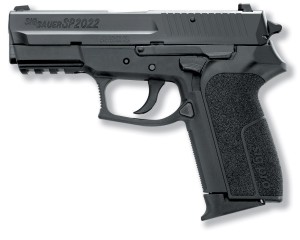 There are a lot of reasons you might want to own a Sig Sauer pistol, there are a lot of reasons you might want to own a polymer-framed pistol, and there are a lot of reasons that the SP2022 is probably the gun you want to settle on when sifting through the hundreds of options. An exploration of these reasons and the answers to questions you have about owning a polymer-framed Sig is what this article is about.
There are a lot of reasons you might want to own a Sig Sauer pistol, there are a lot of reasons you might want to own a polymer-framed pistol, and there are a lot of reasons that the SP2022 is probably the gun you want to settle on when sifting through the hundreds of options. An exploration of these reasons and the answers to questions you have about owning a polymer-framed Sig is what this article is about.
Sig Sauer classic models are essentially alloy-framed, steel-slide weapons made famous by their close tolerances and tight feel, paired with their uncanny reliability and appeal to law enforcement and military special units.
In its history, the Sig Sauer classic lineup has been in the hands of just about every special forces unit and every elite law enforcement agency or unit from around the world at one time or another. In many cases, the weapon was eschewed in favor of a lower-cost alternative when it got equal marks for usability and functionality within the group’s standard protocols. Historically Sig Arms has been an expensive option, mostly because of the intricate details and high tolerance machine work, not to mention the heavy research and development spending and innovative design work Sig is famous for.
The Bad Guys Are Getting Desperate…As A Patriot You Must Know How To Hide Your Guns!
Sig guns finally challenged their way of thinking when in 1998 they released the SigPro 2340, a response to the incredible success of the Glock series of pistols. Sig, while it was the go-to for many elite forces groups in the late eighties and early nineties, was now losing a lot of ground to the Glock in most of the world along with several other manufacturers in the United States. Oddly, even with a reduced price point, the SigPro failed to disrupt the heavy flow of service pistols from Glock, H&K, S&W, and other makers.
It wasn’t until later, when the SP2022 was released, that law enforcement agencies started taking a good hard look at the gun for its many options and built in features.
Since its introduction, the French National Police and several elite units have adopted the weapon as a duty weapon and ordered some 250,000 units in total. Similarly, the U.S. DEA (Drug Enforcement Agency) has switched to the SP2022 and has ordered many thousand units (with some estimates totaling more than 65,000). The Colombian National Police force (a highly militarized unit trained in part with help from the U.S. DEA) also adopted it as the weapon for duty amidst a decline in their overall cocaine production over the last five years. It isn’t necessarily an indication that the 60,000 new SP202’s are that much better as to single-handedly decrease drug activity of what was once the largest exporter of cocaine in the world; rather, it shows that the force is a well-trained group, capable of high tech and effective operations, and therefore, their endorsement of a specific sidearm certainly holds some weight. The Portuguese, Malaysians and Swiss (yes, the guys who used to carry the amazing Sig P210, a “Rolex” of a gun) all have specialized units within military and law enforcement that rely on this gun as their duty firearm.
Several large-name SWAT and special forces groups around the United States and abroad have shortlisted this weapon as a potential successor to their current duty weapons, and it is likely that some of them will move forward with that purchase in light of the concerns that Glock had early on with its Generation 4 guns (function wise) and the cost increases from a contract perspective of HK firearms. The move to fully integrated and lighter-weight duty weapons has all but saturated the law enforcement stage, and certainly Sig has had enough time to prove the reliability and longevity parameters that perhaps cost them some early interest upon the introduction of the original SigPro, the 2340.
From the perspective of a gun owner or civilian, a law enforcement endorsement doesn’t necessarily have a practical implication on whether or not to buy something. However, what it does do is it tells a civilian user that the workmanship and materials are up to a specific standard and will be able to function reliably in most conditions they may find themselves in. Furthermore, it puts within their reach a weapon of exceptional quality for an affordable cost. The SigPro SP2022 can be had for around $350 new in box during sales and special events. Regardless of the MSRP stated from factory, quite frequently retailers (especially those online) will have this weapon for anywhere from $399 to $469, a more than reasonable price point for a gun modeled after other Sigs in the $1000+ range and for something which offers an incredible trigger, an integrated picatinney rail, and a polymer frame with as tight a slide fit as the SP2022 offers. What you are getting is a long history of excellent weapons from a manufacturer who prides itself on reliability and functionality at a price point normally reserved for middle-of-the-road weapons.
Why is the pricing so low for a Sig? The polymer frame and the same slide manufacturing jigs as the other guns at the manufacturing plant combine with big law enforcement and military contracts to lower the ongoing R&D costs along with the cost of dies, molds, and machine jigs.
The lack of frame machining allows Sig the ability to use those previously occupied CAD mills to produce other guns, whose larger markup (due to heavier machining and material costs) allow for more savings to the consumer in other model ranges.
Keep Your Handgun Locked and Loaded, Ready For Instant Use – Without Fear Of An Accident!
Polymer materials cost about 1/50th of what special alloys of aluminum cost to buy, and the manufacturing process is about 1/100th of that of aluminum or steel (when extrapolated for long term costs of tooling), so the ongoing costs can be passed through at a significantly reduced cost to the end user.
The polymer is more flexible than aluminum and is more resilient to damage from drops and the like, so return rates are lower, defects and concerns can be sorted out prior to firing, and overall there is less waste in the process.
What it isn’t: It isn’t the tightest fitting or highest tolerance Sig made, and it certainly is made for a different market segment than some of the premium Sig offerings. It isn’t a trophy piece or a safe queen, and it probably isn’t the prettiest piece off a manufacturer’s line in the history of the world.
What it is: It is a low-cost alternative for the Sig lover; a fully functional, accurate and reliable firearm capable of heavy loads and extreme duty; a well-established brand at the price point of an imposter; and a better looking gun than many other polymer-framed weapons. It is a very flexible and customizable chassis with grip inserts and other customizing options.
Essentially you are getting many decades of engineering, research, and development, as well as an excellent brand name, for peanuts. It’s available in three calibers that all have a history of being good or very good defensive cartridges (9mm, .357 Sig, and .40 S&W), if not the venerable .45ACP or 10mm. But if you love the .45 or the 10mm, you already likely own one and this is a secondary purchase anyway. Look at this weapon if you need something that can function as a stone-cold defensive weapon or a fun-to-shoot range gun, because in this price range with a gun so well built, it’s hard to find flaws.
©2012 Off the Grid News
 Off The Grid News Better Ideas For Off The Grid Living
Off The Grid News Better Ideas For Off The Grid Living




